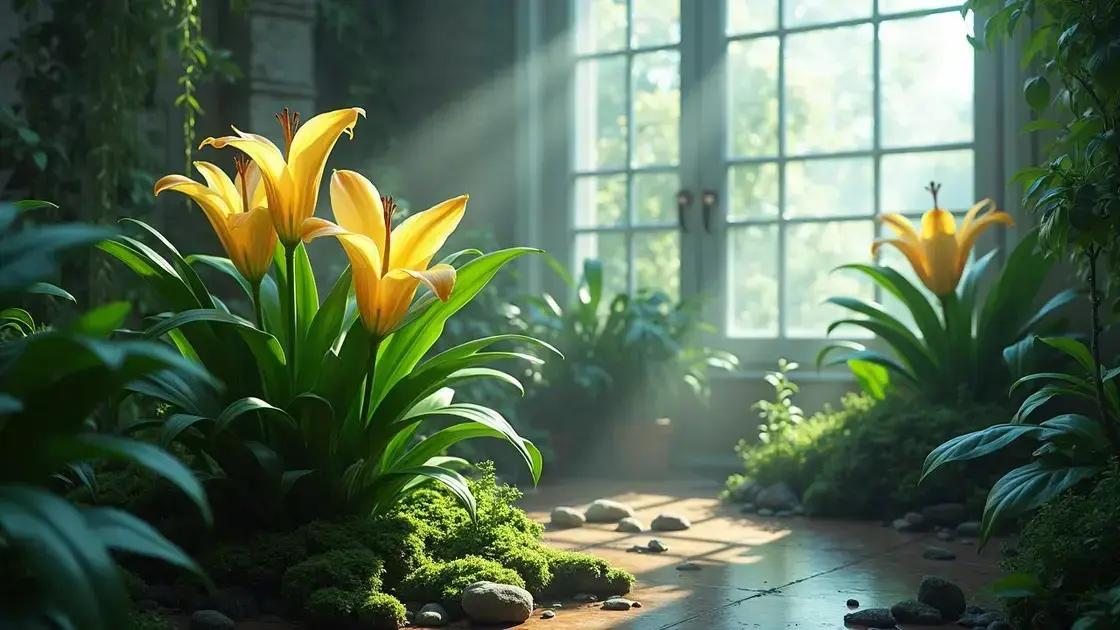How to Care for Lily Plant Indoors: 5 Essential Tips for Thriving Growth
How to care for lily plant indoors? The beauty of indoor plants lies in their ability to elevate any space, bringing life and color into your home. However, it’s essential to know how to nurture them correctly, ensuring they thrive in your environment. Through proper watering, adequate lighting, and pest control, you can create the ideal conditions for your lily plants to flourish.
Table of Contents
ToggleWatering techniques for indoor lily plants
Watering techniques for indoor lily plants are crucial for maintaining their health and vibrant blooms. Proper watering ensures that your lilies thrive in an indoor environment.
Understanding the watering needs of lily plants
- Lily plants prefer well-draining soil that retains moisture without becoming waterlogged.
- It’s essential to allow the top inch of soil to dry out between waterings to prevent root rot.
- Observe the leaves; yellowing may indicate overwatering, while browning tips can suggest underwatering.
Best watering practices
- Use room temperature water: Cold water can shock the roots, so ensure your water is slightly warm.
- Water thoroughly: When you do water, ensure that the entire root ball is saturated, allowing excess water to drain from the bottom.
- Frequency: Generally, watering once a week should suffice, but adjust according to humidity and temperature.
Tips for efficient watering
- Check soil moisture using your finger; if the top inch is dry, it’s time to water.
- Add a layer of mulch on top of the soil to help retain moisture.
- Consider using self-watering pots to easily maintain consistent moisture levels with less effort.
Signs of improper watering
- Overwatering: Signs include wilting despite wet soil, yellow leaves, or root decay.
- Underwatering: Droopy leaves and dry soil on top indicate your plant is thirsty.
For more detailed information on maintaining indoor plants, consider exploring indoor gardening techniques. This can enhance your knowledge about different aspects of indoor gardening, including the specific needs of lilies.
Quick watering checklist
| Indicator | Action |
|---|---|
| Soil dry 1 inch down | Time to water |
| Yellowing leaves | Reduce watering |
| Drooping leaves | Check for moisture |
Mastering the right watering techniques for indoor lily plants will ultimately lead to stunning blooms and a healthy indoor garden.
Optimal lighting conditions for thriving lilies

Optimal lighting conditions for thriving lilies include providing the right balance of natural light to ensure healthy growth and beautiful blooms.
Understanding light requirements for lily plants
- Lilies generally prefer bright, indirect sunlight, which mimics their natural habitat.
- Direct sunlight can scorch the leaves, while too little light can stunt growth.
- South-facing windows are often ideal, but be mindful of intensity.
How to assess light conditions
- Check the placement: Ensure your lily plant is positioned to receive ample light throughout the day.
- Observe the leaves: Healthy lilies should have vibrant green leaves; yellowing may indicate insufficient light.
- Use a light meter: This tool helps measure the amount of light your plant receives.
Artificial lighting options for indoor lilies
- Fluorescent lights: Great for providing the necessary light spectrum, especially in darker spaces.
- LED grow lights: Energy-efficient and effective, these can be adjusted to different heights as your plant grows.
- Incandescent bulbs: Not recommended; they produce too much heat, which can harm plants.
Signs of inadequate lighting
- Stretching stems indicate the plant is seeking more light.
- Leaves turning brown or dropping can signify stress from poor lighting.
For more insights on indoor plant care, consider exploring indoor gardening techniques. This can help you create the perfect environment for your lilies and other indoor plants.
Quick tips for optimizing light for lilies
| Light Condition | Action to Take |
|---|---|
| Too little light | Move to a brighter location or add supplemental lighting. |
| Too much direct sunlight | Relocate away from direct sun or use sheer curtains. |
| Ideal light | Maintain current positioning while observing plant growth. |
By mastering the optimal lighting conditions for thriving lilies, you can enjoy their stunning flowers and make them a beautiful addition to your indoor space.
Common pests and solutions for lily plant care
Common pests and solutions for lily plant care play a crucial role in maintaining the health and beauty of your indoor lilies. Identifying and addressing these issues promptly can help your plants flourish.
Identifying typical pests on lily plants
- Aphids: Small, green or black insects that tend to cluster on new growth, sucking sap.
- Spider mites: Tiny, red or brown pests that create webs on the underside of leaves.
- Mealybugs: White, cottony-looking insects that cling to stems and leaves.
- Fungus gnats: Small flying insects that are often associated with overly damp soil.
Effective solutions for pest control
- Regularly inspect your plants for signs of pests or damage.
- For aphids, spray a mixture of soap and water directly on the insects.
- Use neem oil or insecticidal soap for spider mites and mealybugs.
- Set yellow sticky traps to catch fungus gnats.
Preventive measures for pest management
- Ensure proper watering to avoid soggy conditions that attract pests.
- Maintain good air circulation around your lily plants.
- Regularly clean leaves with a damp cloth to remove any dust and potential pests.
Signs of pest infestations
- Wilting leaves or stunted growth could indicate pest damage.
- Small holes in leaves may be a sign of active feeding.
- Visible webs or sticky residue on leaves can suggest spider mites or aphids.
To understand more about caring for indoor plants, consider exploring indoor gardening techniques. This resource can provide additional insights into pest control and indoor plant maintenance.
Pest control checklist for lilies
| Pest Type | Identification | Solution |
|---|---|---|
| Aphids | Small and usually green or black | Use soap and water spray |
| Spider mites | Tiny, often cause webbing | Apply neem oil |
| Mealybugs | White, cottony clusters | Wash off with soap solution |
By learning about common pests and solutions for lily plant care, you can effectively safeguard your indoor plants and encourage their vibrant growth.
In conclusion
Caring for lily plants indoors requires attention to various aspects, including optimal watering techniques, adequate lighting conditions, and vigilance against pests. By implementing the tips discussed in this guide, you can foster a thriving indoor environment for your lilies, allowing them to flourish and beautify your space. For even more valuable insights to enhance your indoor gardening experience, check out tips on enhancing your indoor garden.

